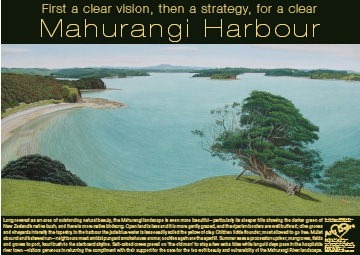What time’s the tide on Saturday 24 January 2060?

Brighter images: The Mahurangi Harbour poster hanging at Ransom Wines might have faded in the strong light but until that is replaced with a fresh copy, the vibrant paintings that marine artist Paul Deacon has donated for auction at the Mahurangi Regatta are on display there. artist Philip Kilmore
Speculative and unhelpful.
These are the words the Honourable Peter Salmon QC used when chastising the New Zealand Herald for its front page announcing Auckland is to become a super city with a London-style mayor with executive powers.
In May 2008, at the Royal Commission on Auckland Governance hearings, Justice Salmon wrapped mayor Penny Webster’s knuckles, saying that if the billboard campaign the Rodney District Council waged in Wellington was an attempt to influence the commission then it was improper.
Many might reasonably assume that the New Zealand Herald has based its story a reliable source, and think that the commission, in one of its very few press releases, was being a bit precious. But just as the Rodney District Council failed its ratepayers by going negative, the New Zealand Herald, has also failed its, readers. The newspaper, rather than present a super city as a done deal, should be assisting the conversation about the future governance of the Auckland region.
A good place for it to start is Auckland 2060. In writing Auckland 2060—commissioned by the commission—Rod Oram just became New Zealander of the year. At least in the eyes of the Mahurangi Magazine. Number nine of nine papers published by the Royal Commission on Auckland Governance, Auckland 2060 is arguably the single most important.
Only by creating Auckland region scenarios fifty years into the future, are we able to backcast the present, and thereby determine by what route we might work towards the future we want. At the end of his report, Rod chooses Auckland Anniversary Day as the setting in which to charmingly depict a day in the life of the metropolis, in 2060—sublime and real. And talk about an open invitation to produce a companion Mahurangi ‘day in the life of’, for regatta day, Saturday 24 January 2060!
While waiting for that pleasure, the scenario printed on the much-cherished Philip Kilmore Mahurangi Harbour poster may serve:
Long revered as an area of outstanding natural beauty, the Mahurangi landscape is even more beautiful—particularly its steeper hills showing the darker green of Aotearoa’s indigenous forest, and there is more native birdsong. Open land is less and is more gently grazed, endless harakeke buffers riparian borders; olive groves and vineyards intensify the tapestry. In the harbour the jade blue water is less-readily soiled the yellow of clay. Children find flounder; most are freed. Kahawai run and mullet abound—neighbours meet amidst pungent smokehouse aroma; cockles again are the aperitif. Summer sees a procession upriver; mangroves, fields and groves to port, kauri forest to the starboard skyline. Salt-caked crews prevail on the skipper to stay a few extra tides—slow days to savour the hospitable river town. Visitors return the compliment with staunch support for the care for the all-too-soft beauty of the Mahurangi River landscape.
Meantime the editor, who should not this minute be taking time out from regatta preparations, can’t help wondering: What time’s the tide, on 24 January 2060?
